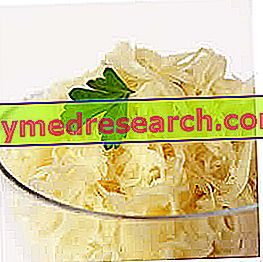Generality
Sauerkraut (or rather, Sauerkraut ) is a food obtained by salting and lactic fermentation of raw cabbage (Brassicaceae family, Brassica genus, L oleracea species, capitate subspecies and Filderkraut Spezialzucht variety - early white).

The term "sauerkraut" has German origins and etymologically derives from the term " Kraut ", which in a broad sense means "grass"; the food in the strict sense (which in Italy is specifically known as "sauerkraut"), in the mother tongue is called Sauerkraut (translated "cabbage acids")
Sauerkraut is particularly widespread in the central-northern areas of Europe, with a continental and tendentially cold climate; their consumption is extended in Germany, in Austria, in the north-east of Switzerland (German cantons), in the northern regions of Italy (Trentino Alto Adige, Friuli Venezia Giulia, Veneto), in Hungary, in Poland, in Slovenia, in the Croatian hinterland, in Serbia and in many of the countries of the former Soviet Union.
Sauerkraut is distinguished from the raw cabbage for its salty and acid taste, while the nutritional profile is partially altered ... but not necessarily impoverished; sauerkraut is distinguished from fresh food by:
- Minor vit content C (ascorbic acid)
- Greater content of B vitamins (following fermentation)
- Greater sodium chloride content (NaCl - cooking salt).
Preparation
Sauerkraut can also be produced at home. First of all it is necessary to find Filderkraut Spezialzucht head cabbage, wash it externally, clean it by removing the external leaves and cut the edible part into thin slices; then place the edible in a large container (like a bucket) by stratifying the vegetable and salting it for 2.25-2.5% (salt prevents the growth of Gram negative bacteria and favors useful ones). At the end of the arrangement, it is necessary to place a weight that compresses the whole, allowing it to drain from the water released by salting and fermentation. Finally, cover the container and let it cool for a few days (about 2) to reach a sufficient level of acidity (about 1.6-1.8% with 1.0-1.3% of lactic acid and a pH between 3.1 and 3.7).
Sauerkraut - How to prepare and store them at home
X Problems with video playback? Reload from YouTube Go to Video Page Go to Video Recipes Section Watch the video on youtube| Nutrient composition Sauerkraut | |||||||||||||||||||||||||||||||||||||||||||||||||||||||||
 | |||||||||||||||||||||||||||||||||||||||||||||||||||||||||
Nutritional values (per 100 g of edible portion)
| |||||||||||||||||||||||||||||||||||||||||||||||||||||||||
Generally it is NOT necessary to use microbial starters for the preparation of sauerkraut since the useful bacterial flora is that GIA 'present on the raw food; the latter are essentially sticks and lactic cocci, to be precise: Leuconostoc mesenteroides, Leuconostoc fallax (the Leuconostoc have a shorter generation and vital time); subsequently: Lactobacillus plantarum, Lactobacillus brevis. Pedicoccus cerevisiae and Enterococcus faecalis intervene in the final stages of fermentation of sauerkraut.
Sauerkraut gone bad
Why does it happen?
The alteration of the bacterial flora necessary for the production of sauerkraut determines the inedibility of cabbage; the most common manifestations are: soft sauerkraut, viscous sauerkraut, rotten sauerkraut and pink sauerkraut. Let's see in detail:
- The softening of sauerkraut takes place when the bacterial species that should take over in the final stages ( Lactobacillus plantarum, Lactobacillus brevis, Pedicoccus cerevisiae and Enterococcus faecalis ) develop in advance
- Sauerkraut becomes viscous due to the excessive development of Lactobacillus cucumeris and Lactobacillus plantarum, which occurs mainly at high temperatures
- The rot can be caused by other bacteria, molds or yeasts
- Finally, the pink color is favored by the growth of Torula spp., especially Torula glutinis .
WARNING! Although fermentation can be successful, sauerkraut (if not properly preserved) is still subject to deterioration; this occurs following the surface mycotic proliferation and the relative rise in pH, which is again suitable for undesired bacterial growth.
Nutritional characteristics
The intake of energy nutrients of sauerkraut is not very different from that of fresh cabbage.
As anticipated, sauerkraut is a vegetable preserved and subjected to considerable oxidative stress; moreover, to be preserved in the long term, they require packaging and the consequent pasteurization, without considering that, before consumption, they should be sautéed in a pan. All these aspects (oxidation and heat treatment) cause a noticeable lowering of the total ascorbic acid (vit. C).
As far as mineral salts are concerned, sauerkraut contains high amounts of sodium, which makes them unsuitable for an anti-hypertension diet. On the other hand, they are also rich in choline (vit. J), a substance potentially useful for reducing circulating homocysteine as a cardiovascular risk factor.
Sauerkraut, using bacterial fermentation, also contains good amounts of cobalamin (vit. B12), a limiting factor in strictly vegan diets.
Bibliography:
- Food microbiology - James M. Jay, Martin J. Loessner, David A. Golden - Springer - page 191.



